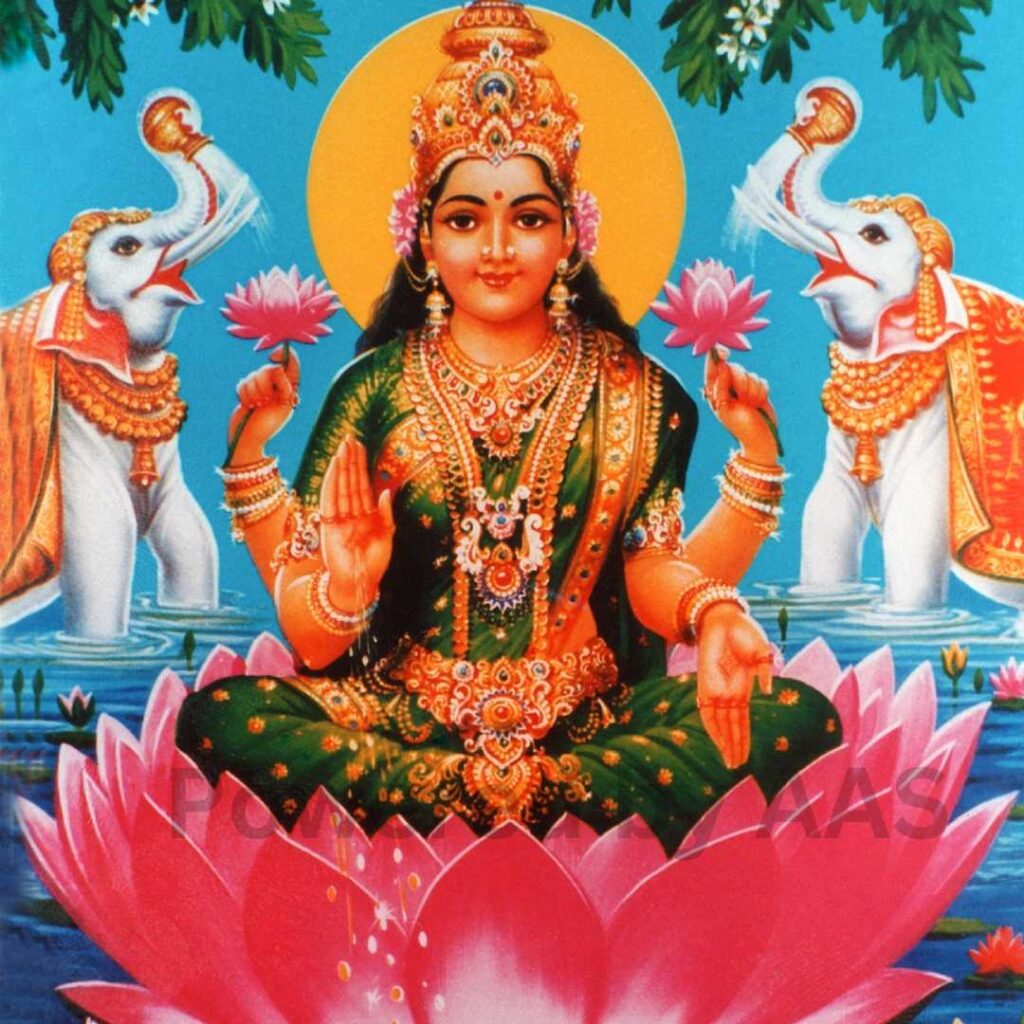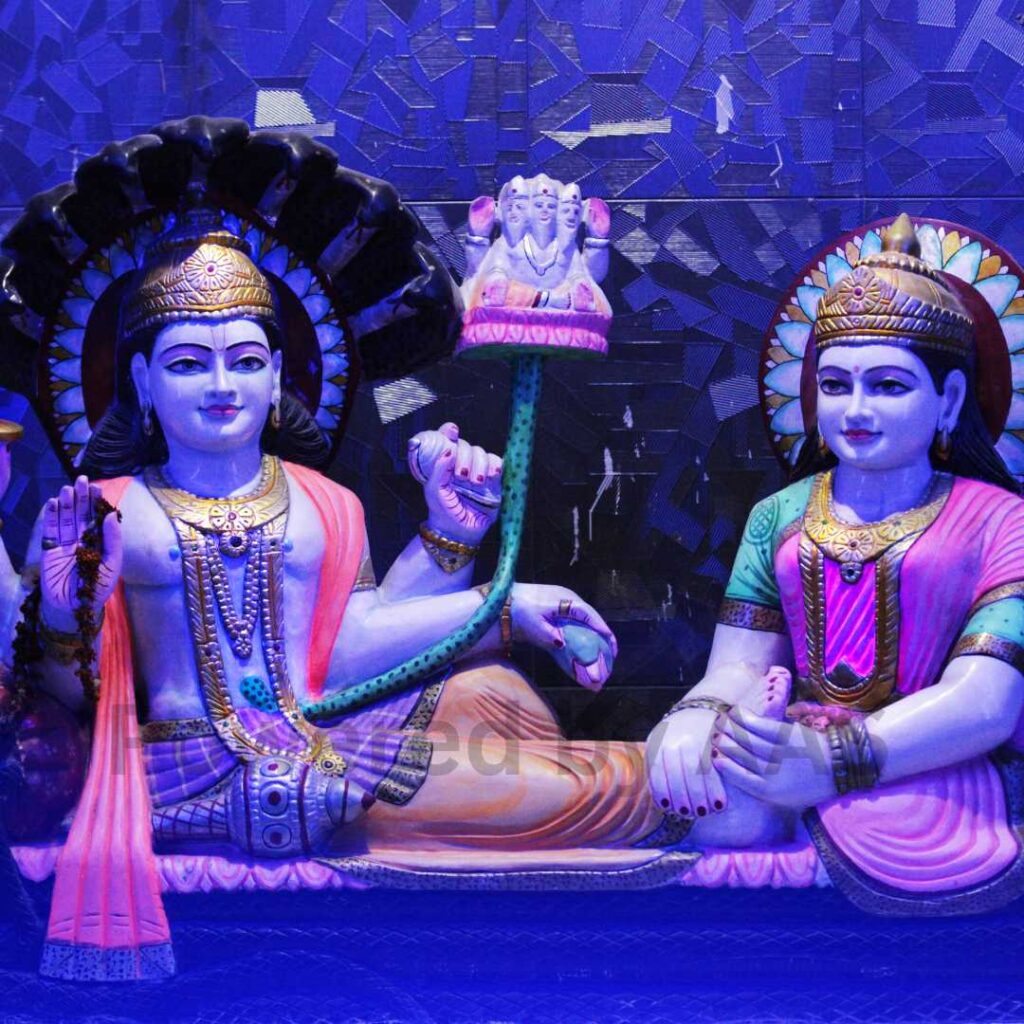Table of Contents
Toggleयथा सर्वगतोऽप्यात्मा न लिप्यते लोकेन संप्रभुः।
सर्वत्रावस्थितो देहे तथात्मा न लिप्यते।।
Just as the lotus leaf remains untainted by water, the soul, though present everywhere, remains unaffected by the material world.
Hello friends.
Welcome to our website. Today, we are going to discuss the symbolism of the lotus flower in Hinduism. The lotus flower, known as ‘Padma’ in Sanskrit, holds a significant place in Indian culture and religion. Its beauty and sanctity have made it an important symbol in the depiction of deities and religious scriptures. This flower is not only important from a religious standpoint but also from a spiritual and cultural perspective. Let’s explore how this beautiful flower represents various aspects of Hindu beliefs and practices.
The Natural Beauty and Characteristics of the Lotus
The lotus flower grows in muddy waters but maintains its purity and beauty. This unique characteristic makes it a significant symbol in Hinduism. The leaves and petals of the lotus repel water and dirt, signifying that a person should live in the world without being affected by its impurities and distractions. The lotus’s ability to remain unstained by its environment is a metaphor for spiritual purity and detachment. It teaches that one should rise above the worldly attachments and illusions (maya) and lead a life of virtue and clarity.

The Relationship Between Deities and the Lotus
Goddess Lakshmi & Lotus
In Hinduism, Goddess Lakshmi, the deity of wealth, prosperity, and fortune, is often depicted seated on a lotus flower. This imagery symbolizes several profound concepts:
Purity and Beauty
The lotus grows in muddy waters but remains pure and beautiful, symbolizing how Goddess Lakshmi embodies purity and beauty despite being associated with material wealth. It conveys that true prosperity and fortune come with purity of heart and soul.
Wealth and Prosperity
The lotus is also a symbol of wealth and abundance. Lakshmi’s association with the lotus signifies that material wealth and spiritual purity can coexist. It teaches that ethical and moral integrity should accompany the pursuit of wealth.
Spiritual Elevation
Goddess Lakshmi seated on a lotus also represents spiritual elevation. It suggests that true wealth includes not just material riches but also spiritual growth and enlightenment. The lotus here acts as a reminder that wealth should be used for righteous and noble purposes and should elevate one’s soul.

Lord Vishnu
Lord Vishnu, the preserver of the universe, is often depicted with a lotus emerging from his navel, on which Lord Brahma is seated. This depiction is rich with symbolic meaning:
Creation of the Universe
The lotus emerging from Vishnu’s navel signifies the origin of the universe. Lord Brahma, seated on the lotus, represents creation, highlighting that the universe originates from a divine and pure source. This imagery emphasizes the interconnectedness of creation, preservation, and the divine.
Symbol of Purity
The lotus here again signifies purity. It shows that the creation of the universe itself is a pure act, coming from a divine source. Vishnu’s navel, from which the lotus originates, symbolizes the central point of the cosmos, from where life and creation emanate.
Balance and Harmony
The relationship between Vishnu and Brahma, mediated by the lotus, symbolizes the balance and harmony in the cosmos. Vishnu’s role as the preserver and Brahma’s role as the creator are interdependent, illustrating the cyclical nature of the universe where preservation and creation go hand in hand.

Goddess Saraswati
Goddess Saraswati, the deity of knowledge, arts, and music, is also associated with the lotus. Her depiction on a lotus flower symbolizes several important aspects:
Purity of Knowledge
The lotus, growing unstained in muddy waters, symbolizes the purity of knowledge. Saraswati seated on the lotus signifies that true knowledge is pure and untainted. It implies that knowledge should be pursued with a pure mind and heart.
Wisdom and Clarity
The purity of the lotus reflects Saraswati’s wisdom and clarity of thought. It signifies that to attain true wisdom, one must strive for mental and spiritual purity. The lotus represents the clarity that knowledge brings, lifting individuals out of ignorance and darkness.
Spiritual Awareness
Saraswati seated on the lotus also indicates that the pursuit of knowledge and arts should lead to spiritual awareness and growth. It teaches that art and science are not merely for intellectual pursuit but also for the elevation of the soul. The lotus underscores that intellectual endeavors should be rooted in spiritual values and ethical principles.
These three major deities’ association with the lotus not only highlights their attributes and powers but also teaches us that purity, integrity, and spirituality are essential in attaining and utilizing wealth, knowledge, and creative powers appropriately.

Its Importance in Religious Texts
The lotus is frequently mentioned in ancient texts such as the Vedas, Puranas, and Upanishads. In the Bhagavad Gita, Lord Krishna explains to Arjuna that just as the lotus flower remains untouched by the water, one should live in the world without being affected by it. This analogy is used to teach the importance of remaining detached and maintaining purity in the face of life’s challenges and temptations.
Symbolism of the Lotus in Meditation and Yoga
It holds a special place in meditation and yoga as well. The ‘Padmasana’ or lotus position, in which meditation and spiritual practices are performed, resembles the lotus flower. This posture symbolizes mental peace and stability. Its position is considered ideal for meditation as it aligns the body in a way that promotes concentration and serenity. This position helps the practitioner to achieve a state of balance and harmony, mirroring the lotus’s representation of purity and spiritual elevation.

Cultural and Social Significance
In Hinduism, it is used in various festivals and ceremonies. This flower is prominently featured in weddings, pujas, and other religious rituals. It is believed to bring good fortune and prosperity. Besides its religious use, it also holds an important place in Indian art, literature, and music. It is a common motif in traditional paintings, sculptures, and folk songs, symbolizing beauty, grace, and divine connection.
Spiritual Significance
This flower is a symbol of the purity and elevation of the soul. It represents how a person can rise above worldly attachments and move towards spiritual growth. The lotus signifies the soul’s purity, knowledge, and spiritual awakening. It teaches that regardless of life’s difficulties, one should maintain purity, integrity, and strive for spiritual progress. The lotus is a reminder that the true essence of life lies in spiritual enlightenment and inner peace.

The lotus flower in Hinduism is not just a plant but a profound symbol representing purity, beauty, and spiritual elevation. It teaches us that no matter how many challenges we face in life, we should maintain our purity and integrity and move towards spiritual growth. In today’s discussion, we explored how the lotus is integrated into various aspects of Hinduism and its significance in our lives.
I hope you enjoyed this blog and learned something new about the symbolism of the lotus. If you find this information useful, please visit our website and don’t forget to like and share this log. We will meet again in new blog with a new interesting topic.
Thank you.
जय श्री राम।।
Please Share Through Various Platforms.
Sharad Purnima – Revolutionary Rituals & its importance
या देवी सर्वभूतेषु शक्ति-रूपेण संस्थिता।नमस्तस्यै नमस्तस्यै नमस्तस्यै नमो नमः॥ i.e., “Salutations again and again to the Divine Goddess who dwells in all beings in the form of power (Shakti).” Hello friends. Welcome to our Website. This blog is going to be a sensation for everyone thinkers definitely. In this blog, we will talk about The Great Iron Man: – Sardar Vallabhbhai Patel & his thoughts and actions for Hindus & Hindu visions. In the vast
Durga Puja: Mahashaptmi Significance, Rituals, and Spiritual
या देवी सर्वभूतेषु शक्ति-रूपेण संस्थिता।नमस्तस्यै नमस्तस्यै नमस्तस्यै नमो नमः॥ i.e., “Salutations again and again to the Divine Goddess who dwells in all beings in the form of power (Shakti).” Hello friends. Welcome to our Website. As the warm colors of autumn mix with the sweet smell of shiuli flowers and the lively beats of dhak drums, Durga Puja 2025 begins on Mahashashthi, which is September 28. This five-day event is full of deep devotion, beautiful

“Navaratri: A Pivotal Tour of Inner Power and Divine Triumph”
या देवी सर्वभूतेषु शक्ति-रूपेण संस्थिता।नमस्तस्यै नमस्तस्यै नमस्तस्यै नमो नमः॥ i.e., “Salutations again and again to the Divine Goddess who dwells in all beings in the form of power (Shakti).” Hello friends. Welcome to our Website. Today we will discuss a topic i.e., Navratri: A Vibrant Nine-Day Festival of Devotion, Dance, and Divine Power. Navratri, meaning “nine nights” in Sanskrit (“nava” for nine, “ratri” for nights), is one of India’s most colorful and spiritually significant Hindu

Mahalaya Amavasya: A Sacred and Spiritual Festival – 02
Mahalaya Amavasya is a sacred Hindu observance marking the end of Pitru Paksha—a period dedicated to honoring ancestors through rituals like shraddha and tarpan. Families across India pay homage to departed souls, seeking their blessings and peace. This day not only upholds the tradition of expressing gratitude to ancestors but also heralds the onset of Devi Paksha and Durga Puja celebrations. Mahalaya Amavasya stands as a beautiful blend of remembrance, spiritual reflection, and the renewal of hope, emphasizing the eternal bond between generations and the cyclical nature of life itself.

महालय अमावस्या: एक पावन और आध्यात्मिक पर्व
ॐ पितृभ्यो नमः।श्रद्धया पितॄन् स्मरामि विश्वपितॄन् च सर्वशः।तेषां पुण्यकृतां देवानां च पितॄणां च वयं नमामः। i.e., Om salutations to the ancestors.With reverence, I remember the ancestors, the universal forefathers who are virtuous gods.To them, the holy ones and the ancestors, we offer our salutations. नमस्कार दोस्तों! स्वागत है आपका हमारे चैनल पर। महालय अमावस्या का यह शुभ अवसर हमारे बीच एक बार फिर उपस्थित हुआ है। यह दिन हिन्दू पंचांग के अनुसार पितृ पक्ष का

Hindutva: The Ultimate Political Empowerment of Culture – 02
नमस्ते सदा वत्सले मातृभूमे त्वया हिन्दुभूमे सुखं वर्धितोहम्।महामङ्गले पुण्यभूमे त्वदर्थे पतत्वेष कायो नमस्ते नमस्ते॥ i.e., O loving Motherland, I always salute you! On this Hindu land, I have grown up happily with your nurture and care. O most auspicious and sacred land, for your sake I offer this mortal body. I bow to you again and again.. Hello friends! Welcome to our Website. Today we will discuss a topic that has deeply influenced Indian politics:

The Symbolism of the Lotus in Hinduism
यथा सर्वगतोऽप्यात्मा न लिप्यते लोकेन संप्रभुः। सर्वत्रावस्थितो देहे तथात्मा न लिप्यते।। Just as the lotus leaf remains untainted by water, the soul, though present everywhere, remains unaffected by the material world. Hello friends. Welcome to our website. Today, we are going to discuss the symbolism of the lotus flower in Hinduism. The lotus flower, known as ‘Padma’ in Sanskrit, holds a significant place in Indian culture and religion. Its beauty and sanctity have made it



